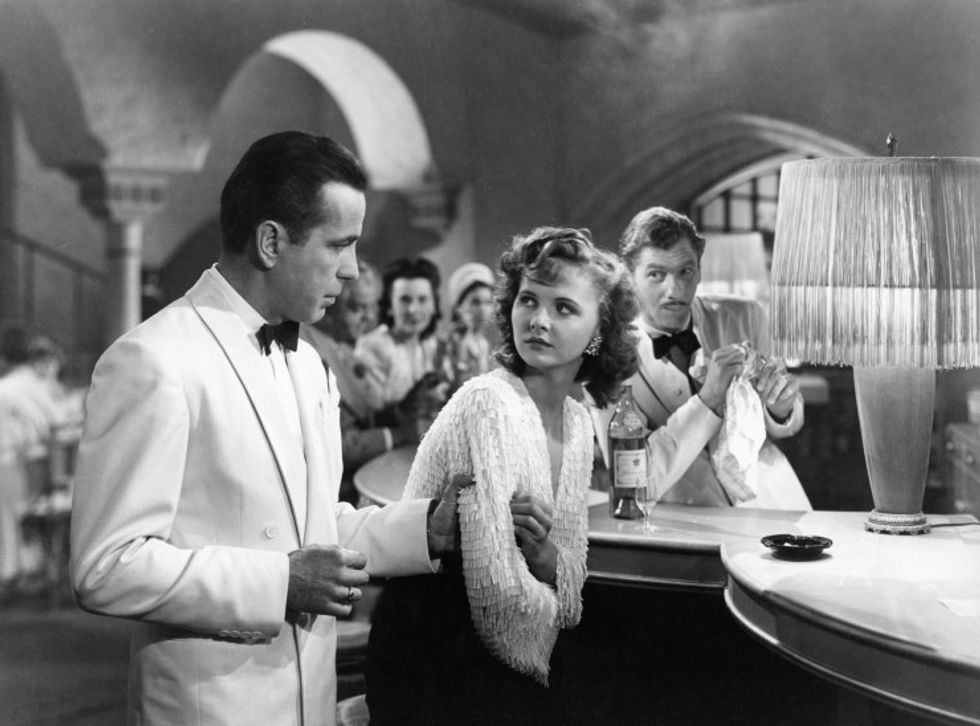Inside the Super Fast Production of a Slamdance Film
This town isn't big enough for the both of us! Well, actually, it is, and while Sundance is incredibly popular, there's another great festival that happens in its midst.

That's Slamdance of course, and here we sit down with Detritus filmmakers T.J. Misny and Kaija Matiss to speak about creative process, TV versus cinema, why film festivals are like sausage factories, and more.
T.J. Misny (who appeared in our FILMMAKER PASS series last year) directed and lensed Detritus, while Kaija Matiss wrote and starred.
All confrontations that are worth having are gonna be messy.
NFS: I watched the film about 15 minutes ago on a laptop at an overpriced sushi place, so it's very fresh in my mind. I liked the smashing of the TV. Media needs to be smashed with some kind of organic material every once and a while.
TJ: Actually I’d never thought about that -- that’s a terrific reading of the film. But, like the ending shot shows, it's also the fact that you can’t totally get rid of it. It’s still gonna get dragged around with you.
Kaija: I was struggling with an ending, and through conversations with TJ, we brought that point up: there are consequences to saying you don't want to be a part of something. It’s not just all great once you smash it, you have to deal with the consequences. And in personal relationships, too, when you confront something it’s not instantly resolved. You have to continue forward with that baggage for better or worse.
TJ: All confrontations that are worth having are gonna be messy. There’s gonna be some residue that you carry around with you.
NFS: If you get people thinking about these things in 8 minutes, then to me it’s a successful piece of work.
TJ: It's funny, I was thinking about dreams in terms of real time -- how long a dream actually lasts. It may feel like you're having this huge, long narrative, but if you were to transcribe the dream at that moment, you're really only getting ten minutes of content out of the dream. I like the idea that this is sort of like a dream and it poses a question and doesn't really tell you what to think. Hopefully, those are the things that'll burrow in and stick with you. I hope.
NFS: Speaking of smashing televisions, what do you think are the differences between TV and cinema?
TJ: If you're at the movie theater, you're looking up at the thing -- you're sitting back and you're looking up at it. With television, your line of sight -- for most people -- the box is a very small part of your field of view, and there's all this other stuff in your house that you're looking at. You're usually looking down at it. It's almost more reverential to be in the cinema in terms of image.
NFS: Unfortunately, I watch most movies like that on my laptop.
TJ: I saw someone watching Gravity on an iPhone. It was amazing.
NFS:It’s hard to draw a line in the sand with anything.
I got the point where I was like, "I don't care if this is the dumbest idea ever. I need to do this or I will regret not taking that jump and putting myself out there for the rest of my life."
NFS: I like the idea of tapping into your dreams, because we've all had amazing dreams that are meaningful, expansive, mind-blowing, and, like you said, there are some dreams that stick with you forever, too. I thought the most dream-like shot was the crane up to the tree. I don't know why, but the tree looks -- not real.
Kaija: I actually came up with the idea of that shot because of a dream that I had. It will stick with me for the rest of my life. It was a lucid dream that I had when I was taking a nap in the afternoon. I realized I was dreaming, and I was like, "Oh, I get to ask and go where I want." So I said, "Take me to the most beautiful place in the universe," and this lovely, golden amber image came up with this tree.
TJ: What I like about that shot is the fact that you're just holding this tree for a minute or whatever -- not a minute. Like 8 seconds --
Kaija: -- One-eighth of the movie.
NFS: -- A dream minute.
TJ: -- and then in the next shot the whole frame is pavement; the idea of looking at this little bit of nature that we're able to preserve, this one tree that remains and is curated by humans. Like it's all so fleeting. I think of moments like you described, but also, in real life, those instances of untouched nature, things that haven't been corrupted yet, then cutting directly to full-frame corruption. It's all gray. It's all pavement.
NFS: How did you guys hook up on this project and what started it?
Kaija: We met 8 years ago when he was at NYU and I was at the New School.
TJ: I know that [Kaija] worked as an actor on shows and commercial projects and different things where she's not saying words that are her words, or expressing things that she deep down really needs to express, so -- she's been wanting to do something that was generated by her.
Kaija: He just heard me talk and complain about it for years before I finally got up the courage. I got the point where I was like, "I don't care if this is the dumbest idea ever. I need to do this or I will regret not taking that jump and putting myself out there for the rest of my life."
NFS: How do you feel about being here in Slamdance? It seems like this little pocket that's carved out of this much larger thing, but how do you approach the festival and what does it feel like to be at Slamdance looking over the fence into Sundance?
Kaija: I feel pretty split. Generally, I don't like it, but for example, I had the opportunity to meet you and Wendy and Rich. Those are the first people that I was like, "Oh, this is a real conversation. Okay.” So I'm getting the sense that those few connections you do make are probably worth the whole circuit.
TJ: I feel a bit differently. I personally really enjoy the experience of seeing how the sausage is made. It's funny that I use that analogy, because I shot something a couple weeks ago where I literally did photograph how sausage is made, and it's actually really disgusting.It's like all these sort of odd ends of meat and it goes in this grinder, and what gives the sausage its form is this clear casing. So, what it looks like is this machine and this guy -- a butcher or whoever it is -- puts this thing that looks like a condom over a faucet, and this meat juice comes out and it fills up and forms the sausage. It's actually really sort of gross, but then I love eating sausage. I had sausage for breakfast, and it was delicious. So, it is sort of the same to see the corporate presence, but it's amazing to see people get a platform to share their work. I love that I can walk down the street, and I'll run into people that I have admired and people I have collaborated with in the past.
NFS: Meat parts. Perfect analogy.
The way we shot it allowed us to edit it in maybe half a day because there was only one way to cut it together.
TJ: I've never had the experience of playing in Slamdance films, but I just like the enthusiasm that the Slamdance team has for -- I almost want to call it outsider art. You sort of feel like an outsider, not in a bad way, but in a good way. You feel like -- not to say that people who are in Slamdance are here for any bad reasons, like they're making corporate movies. They're not. They've making authentic pieces of art, too, but I like the feeling of being celebrated for the reasons that maybe are excluding similar types of work from the big platforms at Sundance.
NFS: What’s it like to be playing in front of a feature? I always wondered how those short filmmakers felt being paired up with another random film.
Kaija: I feel like you've got a bigger spotlight shone on your if you're screening in front of a feature because the feature is a more in-demand ticket.
TJ: I agree with something Kaija said, that the validation of a festival is like a half-truth, and I agree with that statement, but It is always meaningful to me when someone that runs the festival can look you in the eye and they can say, "I really enjoyed your work."
Kaija: The looking in the eye thing, though, I think is the most important part of that. That is a person-to-person connection, which is the whole reason why I want to make film or art.
NFS: How long did you guys make this film? I've got ten things inside of me that I feel like I just need to go make right now, but they usually take longer than I want them to.
Kaija: Once I decided on the idea then it was within two months, I think, that we shot
TJ: It went through the fastest post I'd ever been. We shot over Labor Day weekend, then it was completed within less than a month. The way we shot allowed us to edit it in maybe half a day, because there was only one way to cut it together. All of the shots went to the next one. There was almost no coverage.
Also because the performance is so physical, I though the only way to show the weight of what she's carrying, and to show the physical toll that it's taking, is to have these longer takes of her actually doing the work, because if it was a bunch of cuts you wouldn't get the sense of the labor of it. The rocks she's carrying in the video must have weighed 25 pounds or something.
Kaija: More than 25 pounds.
TJ: I don't know. I didn't carry it.
Kaija: My cat weighs 25 pounds.
As winner of the Kodak Director's Award at this year's Slamdance, they will be awarded $10,000 worth of film for their next project. Perfect timing, as T.J. is gearing up to shoot his first feature on film with DP Adam Newport-Berra.
A big thanks to T.J. and Kaija for lending their time. You can check out their work here and here, respectively.




















